The world's first submarine
Enthusiasts from Massachusetts, led by sculptors Rick and Laura Brown, have restored, based on drawings, a working copy of the Turtle, the first submarine in world history, created in the 18th century by inventor David Bushnell.
The history of combat submarines begins with this unsightly-looking egg-shaped vessel, which represents the very first submarine used in combat conditions. This is the Turtle, created by David Bushnell, an inquisitive inventor who also gave the world the first underwater mine...
In the summer of 1776, the British controlled New York Harbor with a powerful fleet, and the Americans needed to do something to lift the naval blockade. David Bushnell, a Yale University graduate and passionate patriot, invented and built a one-person underwater device.
When developing the idea of a means of delivering a timed mine to the side of an enemy ship, Bushnell considered the “hidden ship” the most suitable means. But in creating the first submarine, its creator faced many design problems.
How to create a waterproof hull that can withstand water pressure, how to provide the ship with the ability to ascend and submerge, and even move, how to ensure the vertical stability of the ship on the surface and under water, control, and, most importantly, what weapons to equip the underwater ship with.
Bushnell managed not only to solve these problems in a unique way, but also to make some new discoveries in engineering - for example, he was the first to equip a submarine with a fan to supply air inside the hull and a two-bladed propeller as a propulsion device.
Historians studying Bushnell's legacy give this creation different names, the most commonly used being "Turtle." The body of the “Turtle” in profile consisted of two identical halves, reminiscent of a turtle shell, connected to each other.
Just over 2 meters high from keel to deckhouse, the hull was assembled from carefully molded oak beams, and all joints were carefully caulked.
To increase strength and water resistance, the entire hull was strapped with steel straps and painted with resin. The length of the vessel was 2.3 m, width - 0.9 m.
The small egg-shaped wooden hull of the submarine dangled like a float even in slight waves, although it was balanced by a lead balancer at the bottom of the hull.
In this hand-operated ingenious boat, one person could dive by opening the valve and drawing water into the ballast tank, or rise to the surface by displacing water from this tank using air pumped into it.
Bibliography
To prepare this work, materials from the site were used
The submarine has origins in different parts of history. The earliest images of a submarine are found in Leonardo da Vinci. There was also a British mathematician who drew up the submarine's plans in the 1570s. However, these people only made diagrams and drawings. Neither da Vinci nor British scientist William Bourne actually created a submarine. The first real working submarine was invented in 1620. Read on and find out who invented the first submarine.
Cornelius van Drebbel - inventor of the first submarine
Cornelius van Drebbel is the man credited with inventing the first submarine. In 1620 he managed to cover wooden boat leather that has been coated with wax to make it waterproof. The oars extended from the side of the boat, the oar holes were covered with lightly wrapped waterproof leather. There are two different theories about how Drebbel and his men were able to remain underwater for almost 3 hours.
How were they underwater?
There is an idea of pipes coming to the surface to provide air to the people in the boat. There is also an idea that Drebbel had a liquid that converted carbon dioxide into oxygen. It was established that he used a pig's bladder as a diving vessel. By filling it with water, the boats sank into the water, and to surface, they pushed the water out of the bubble.
David Bushnell created the first submarine for the army
David Bushnell is the first creator of a submarine for military use. It was in 1776 that he created a wooden one-man submarine. It was equipped with a manual connecting rod that rotated the screw. The idea was to use a submarine to plant explosives under the hulls of British ships. The submarine worked, and worked well, but the small amount of explosives could not sink the ships.
John P. Holland and Simon Lake
John P. Holland and Simon Lake were rival inventors who created the first true submarine. Russia and Japan liked Simon Lake's design, while the US Navy chose John P. Holland's design. They both used steam or gas engines for land-based inventions, while submarines were powered by electric motors.
A submarine is a separate class of ships that are capable of diving to great depths and staying under water for a long time. Today, submarines are the main tactical weapon of the navy of any state. Their main advantage is secrecy. This makes them indispensable in times of war.
History of creation: the beginning
For the first time, Leonardo da Vinci gave a practical answer to the question of what a submarine is. He described its military-tactical advantages and worked for a long time on a mock-up of the device, but in the end he burned all his mock-ups, fearing irreversible consequences.
In 1578, the English scientist W. Bourne in his report identified a certain submarine ship that he noticed in the depths of the Black Sea. The submarine described is nothing more than the first submarine made in Greenland from leather and seal skins. The ship had ballast tanks, and acted as a navigator exhaust pipe. Such a submarine could not remain under water for a long time, but even then it showed amazing results.
The official project to create submarines became public only in 1620. Approval for construction was given by the English King James I. The Dutch engineer K. Drebbel undertook to construct the underwater vessel. Soon the boat was successfully tested in London. The engines of Britain's first submarine were oar-powered. In Russia, the idea of creating a hidden fleet was initiated. However, with his death, the project died in its infancy. In 1834, the first all-metal submarine appeared. Its inventor was the Russian engineer K. Schilder. The propulsion system was rowing devices. The tests were successful, and at the end of the year the world's first underwater missile was launched.
The American fleet could not stand by. In the 1850s, the project began under the leadership of L. Hanley. The boat was controlled from a separate compartment. The engine was a large propeller, which was spun by seven sailors. Observation took place through small protrusions in the body. In 1864, Hanley's first creation sank an enemy ship. Subsequently, Russia and France could boast of similar successes.
During World War I, submarines were equipped with diesel and electric engines. Russian engineers played a major role in the design of the new generation of submarines. During the war, 600 deep-sea vessels took part in the fighting, which ultimately sank about 200 ships and destroyers.
History of creation: a new era
By the time World War II began, the USSR had the largest number of submarines (211 units). In second place was the Italian flotilla - 115 submarines. Next were the USA, France, Britain, Japan and only then Germany with 57 deep-sea vessels. It is worth noting that the submarine was considered the main combat unit of the fleet during the war. This is also proven by the fact that the USSR dominated the surface of the sea and under it until the end of World War II. The submarines were to blame, which sank a total of more than 400 enemy ships. 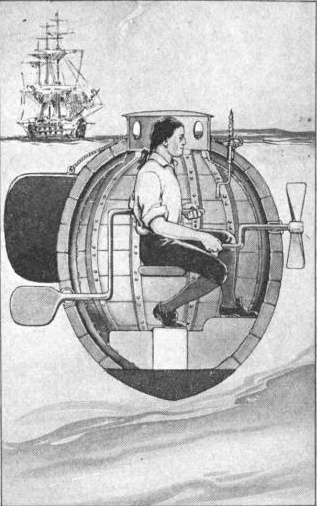 At that time, submarines could dive up to 150 meters, staying under water for several hours. average speed was about 6 knots. The revolution in underwater engineering was made by the famous scientist Walter. He designed a streamlined body and an engine powered by hydrogen peroxide. This allowed the submarines to overcome the speed barrier of 25 knots.
At that time, submarines could dive up to 150 meters, staying under water for several hours. average speed was about 6 knots. The revolution in underwater engineering was made by the famous scientist Walter. He designed a streamlined body and an engine powered by hydrogen peroxide. This allowed the submarines to overcome the speed barrier of 25 knots.
Submarines today
A modern submarine is a deep-sea vessel that uses nuclear power plants to obtain the necessary energy. The submarines are also equipped with batteries, diesel engines, Stirling engines and others. At the moment, the flotillas of 33 countries are rich in such combat units.
Back in the 1990s, NATO had 217 vessels in service, including SSBNs and submarines. At that time, Russia had just under 100 units on its balance sheet. In 2004, the Russian Federation ordered the creation of a small non-nuclear submarine from Italy. The project was called S1000. However, in 2014 he was frozen by mutual consent.  Today, hydrogen submarines are considered one of the fastest and most versatile submarines. These are deep-sea vessels of the U-212 class, which relatively recently began to be produced in Germany. Such boats operate on the basis of hydrogen, due to which maximum noiselessness of movement is achieved.
Today, hydrogen submarines are considered one of the fastest and most versatile submarines. These are deep-sea vessels of the U-212 class, which relatively recently began to be produced in Germany. Such boats operate on the basis of hydrogen, due to which maximum noiselessness of movement is achieved.
Classification of submarines
Submarines are usually divided into groups according to categories:
1. By type of energy source: nuclear, diesel, combined cycle, fuel, hydrogen.
2. By purpose: multi-purpose, strategic, specialized.
3. By size: cruising, medium, small.
4. By type of weapon: torpedo, ballistic, missile, mixed.
The most common deep-sea unit is the nuclear submarine. This type of submarine has its own classification:
1. SSBNs - nuclear submarines with ballistic weapons.
2. SSGN - nuclear submarines with cruise missiles.
3. MPLATRK - multi-purpose missile and torpedo submarines, the main source of energy for which is a nuclear reactor.
4. DPLRK - diesel submarines with missile and torpedo weapons.
Among the experimental types we can distinguish: flying, winged and river uninhabited submarine.
Design Basics
Submarines consist of two hulls: light and durable. The first is designed to give the ship improved hydrodynamic properties, and the second is to protect against high water pressure. The durable case is mounted from, but titanium alloys are also often found. 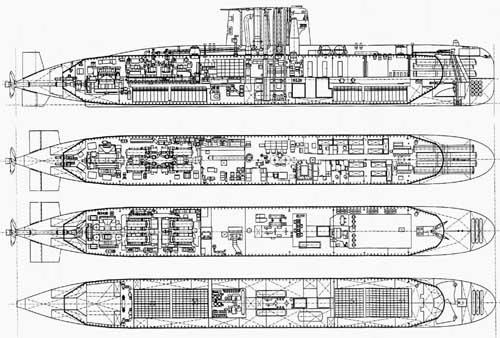 The submarine has special tanks for controlling trim and ballast. The dive is carried out using hydroplanes. Ascent is determined by the displacement of water by compressed air from ballast tanks. The ship is propelled by diesel or nuclear power plants. Small submarines run on batteries and electricity. Special diesel generators are used for recharging. Used as a motor
The submarine has special tanks for controlling trim and ballast. The dive is carried out using hydroplanes. Ascent is determined by the displacement of water by compressed air from ballast tanks. The ship is propelled by diesel or nuclear power plants. Small submarines run on batteries and electricity. Special diesel generators are used for recharging. Used as a motor
Types of weapons
The purpose of submarines is to perform certain tasks:
Destroying warships
- liquidation of multi-purpose vessels,
- destruction of enemy strategic targets.
Depending on the targets, the corresponding types of weapons are installed on the submarines: mines, torpedoes, missiles, artillery mounts, radio electronics. For defense, many deep-sea ships use portable anti-aircraft systems.
Russian submarines
The Halibut submarines were among the last to enter service. The construction of 24 units took about 20 years, starting in 1982. Today Russia has 18 Halibut submarines at its disposal. The boats were built as part of Project 877. These deep-sea ships became the prototypes of the so-called “Varshavyanka”. 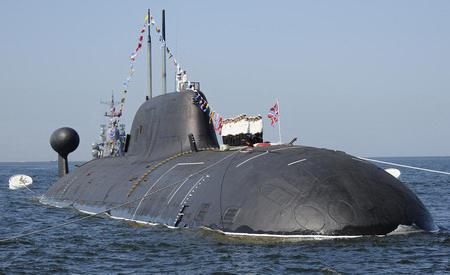 In 2004, the new generation Lada submarine was born, powered by an electric diesel installation. The ship is designed to destroy any enemy objects. These Russian submarines have become widespread due to their minimal noise level. Due to the high cost, the project was quickly cancelled.
In 2004, the new generation Lada submarine was born, powered by an electric diesel installation. The ship is designed to destroy any enemy objects. These Russian submarines have become widespread due to their minimal noise level. Due to the high cost, the project was quickly cancelled.
The main striking force of the Russian flotilla is the nuclear submarine Shchuka-B. The project lasted more than 20 years until 2004. Today, there are 11 submarines of this type in service with the Russian Federation. “Pike-B” is capable of reaching a speed of 33 knots, diving to 600 m and maintaining autonomous navigation for up to 100 days. Capacity - 73 people. The construction of one unit cost the treasury about 785 million dollars.
Also in the fleet's arsenal are such Russian nuclear submarines as Akula, Dolphin, Barracuda, Kalmar, Antey and others.
The latest submarines
In the near future, the Russian Navy will be replenished with new units of the Varshavyanka series. These will be the newest submarines “Krasnodar” and “Stary Oskol”. The boats will enter service in the second half of 2015. At the docks are the deep-sea ships "Kolpino" and " Velikiy Novgorod", but their construction will end only by the end of 2016. As a result, the Black Sea Fleet will have 6 units of the Varshavyanka project on its balance sheet.  Representatives of this series are designed to counter enemy attacks, that is, to protect naval bases, communications, and the coast. The Varshavyanka submarines are classified as silent submarines. Powered by an electric diesel engine.
Representatives of this series are designed to counter enemy attacks, that is, to protect naval bases, communications, and the coast. The Varshavyanka submarines are classified as silent submarines. Powered by an electric diesel engine.
The length of such a submarine is 74 m and its width is 10 m. Underwater, the ship can reach a speed of 20 knots. The diving threshold is 300 m. The voyage period is up to 45 days.
Missing and sunken submarines
Until the 1940s, submarines were constantly lost in the abyss of the seas and oceans. The reasons for this were design flaws, oversights by the commanding staff, and secret military actions of opponents.
After the Second World War, missing submarines are counted in just a few. Over the past 50 years, engineering has reached its peak. Since the early 1950s, submarines were no longer considered dangerous to the lives of the crew, and any contact with the enemy was immediately recorded by the military base. This is why there have been so few lost submarines in recent decades. 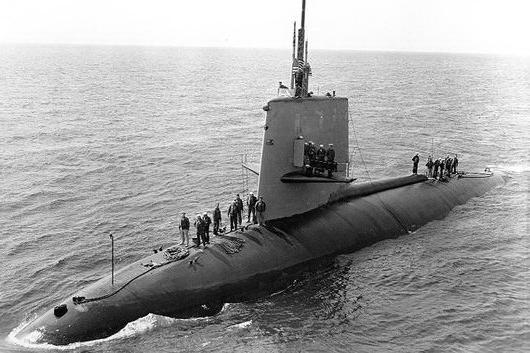 The most famous missing ships are the Scorpion (USA), Dakkar (Israel) and Minerva (France). It is noteworthy that all 3 sunken submarines were wrecked during strange circumstances for 2 weeks in 1968. The reports of all 3 disasters mentioned an unidentified object, after contact with which contact with the crew was lost forever.
The most famous missing ships are the Scorpion (USA), Dakkar (Israel) and Minerva (France). It is noteworthy that all 3 sunken submarines were wrecked during strange circumstances for 2 weeks in 1968. The reports of all 3 disasters mentioned an unidentified object, after contact with which contact with the crew was lost forever.
In total, over the past 60 years, 8 sunken nuclear submarines have been officially recorded, including 6 Russian and 2 American. The first was the ship "Thresher" (USA), which had 129 people on board. The disaster occurred as a result of an enemy attack in 1963. The entire crew died.
The most sensational and tragic is the fate of the Kursk submarine. In the summer of 2000, due to a torpedo explosion in the first compartment, the ship sank to the bottom of the Barents Sea. As a result, 118 people died.
Imagine the situation. You, already a middle-aged officer of the British Navy, are standing on board the British flagship "Eagle". Smoking a pipe, you look into the dark waters of the bay. Soon His Majesty's squadron will begin the assault on New York and it will become really hot. Suddenly, a strange shadow under the water catches your eye: something similar to a fat manatee is approaching your ship. Although, no, it's just a barrel. She swims up to the "Eagle", sadly rubs herself against its side and swims back in the same way. Congratulations, your flagship has just survived the first ever submarine attack.
On September 7, 1776, exactly 240 years ago, the American submarine Turtle attempted to blow up the British frigate Eagle. The idea failed, but it went down in history as the first time a submarine was used during hostilities. Yes, it looked like a dirty barrel, it floated due to the muscular strength of the pilot, and the lighting in it was provided by glowing mushrooms, but in history it is often these freaks who become the first.
David Bushnell and his passion for gunpowder
The year is 1775, the War of Independence breaks out on the territory of the future United States, local colonists are preparing to repel British troops and, at the same time, encircle British gunpowder warehouses. Collecting explosives and muskets is becoming something of a national hobby for every self-respecting patriot. David Bushnell, who was 35 years old at the time, was no exception. He was an ardent inventor and the Revolution, ennobled by the availability of gunpowder, became his muse.

To begin with, Bushnell made two important discoveries, and both were literally big. First, he discovered and proved that gunpowder could be exploded underwater. Secondly, David was able to construct a clock mechanism for a bomb, which was based on a simple flintlock from a musket. You don't have to be particularly clever to manage to combine these two finds and come up with the idea of sea mines. Bushnell was not just insightful, some of the modern military considered him almost a modest genius.
Eventually, his thoughts on how to more efficiently deliver a mine to a ship led him to invent his own submarine. In 1775, he created an unsightly-looking device that was destined to go down in history forever. The "Turtle" he created with his brother, Ezra, had many problems and was almost incapacitated. However, Bushnell had the courage not to abandon the project and bring the project to fruition. The device was tested in the waters of the Connecticut River, and by 1776 it could be called fully operational.
What the first combat submarine looked like
The “turtle” looked like a large pot-bellied barrel, 1.8 meters high and 0.9 meters wide. The ship was propelled by propellers, which were driven by the pilot's feet through a mechanism reminiscent of a bicycle. The device was immersed and lowered thanks to a pump that pumped out or, on the contrary, pumped water into a special tank. The walls of the submarine were made of tarred oak beams, and the structure was completed by a bronze turret with thick glass, through which one could at least roughly guess the outlines of nearby ships.
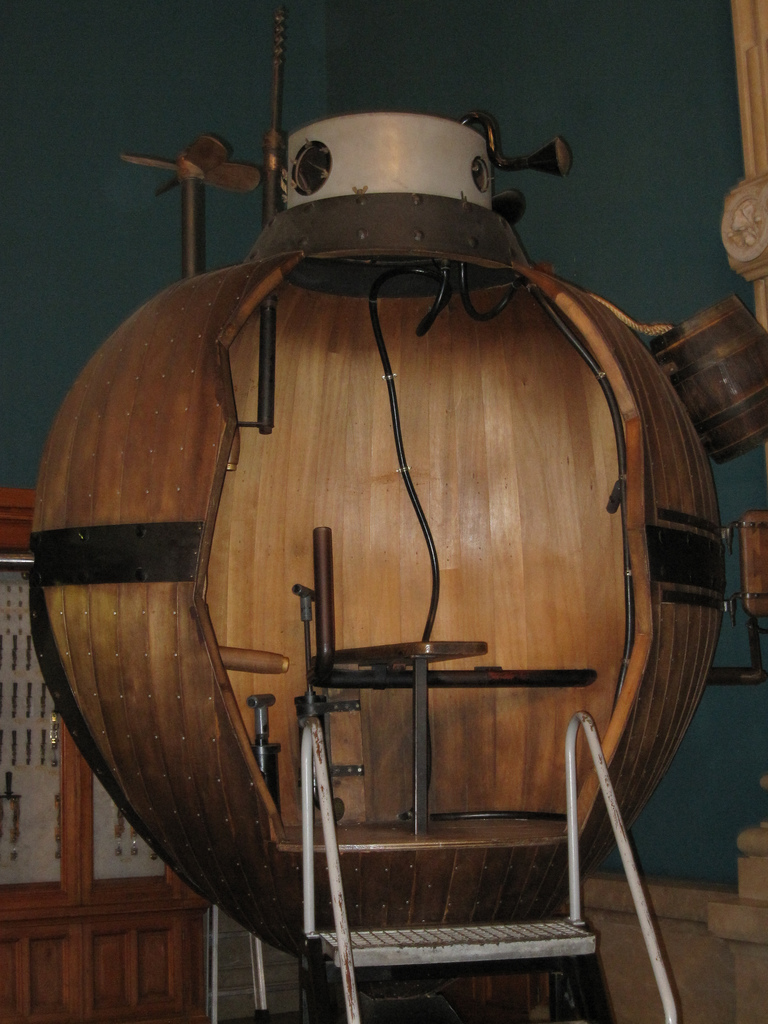
A 90-kilogram load was fastened to the bottom of the Turtle, which could be dropped in case of an emergency ascent. It was possible to navigate in space, except by looking out of the tower, with the help of a compass and a depth gauge. The funniest (and most questionable) part of the description of the Turtle is how exactly the interior lighting was provided. Hanging lanterns in the submarine was not the best idea - they would simply burn all the oxygen that was intended for the pilot of the ship. So David came up with a completely steampunk solution and used phosphorescent mushrooms. They did not play the best role in the performance of the “Turtle” - already during the voyage it was discovered that the mushrooms stop flickering when it gets too cold.
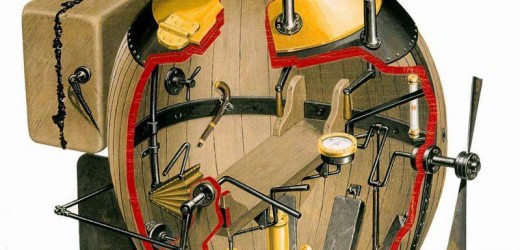
Only one person could fit in the submarine, so he had to be the captain of the ship, the navigator, the miner and the engine at the same time. Ezra Bushnell, the brother of the inventor, agreed to play this role. He trained for almost six months, so he can be called the first professional submariner. In 1776, with the smell of frying and the British preparing to land troops, his time had come. But fate decreed otherwise: Ezra came down with a fever and almost died, and George Washington personally ordered another pilot to be installed and trained as soon as possible. Sergeant Ezra Lee, who volunteered, became the new captain of the Turtle.
"Turtle" attacks "Eagle"
On September 7, 1776, the “Turtle” had a chance to show itself in real action. The British fleet stood in the bay south of Manhattan and prepared to land on New York. The squadron was already in the bay, and something urgently needed to be done. Then it was decided to use a secret trump card and undermine the English flagship. The “Turtle” was urgently delivered to the scene of hostilities and the operation began.

Visibility was poor that day, so the submarine was towed quite close to the enemy. It was assumed that Ezra Lee would somehow cope with everything in half an hour, and that was how much air there was in “Turtle”. He had to pull off an incredibly daring and complex maneuver: swim to the Eagle, drill through its hull with a drill, install a time bomb and sail away without being noticed.

The air began to run out, the pilot almost suffocated, threw a bomb in the hope that it would explode nearby and sailed back to his own. The mission was a failure, and Ezra almost got caught by the British: wanting to quickly replenish his air supply, he surfaced very close to the British ships. The British noticed “something strange”, but did not attach any importance to it, since the object quickly sank under water. The clockwork in the mine did work, and it actually exploded, but only after it had been carried far out to sea.
What happened to "Turtle" and David Bushnell
 After some time, it was decided to use the “Turtle” again for sabotage, but the previous experience played a cruel joke. To prevent the pilot from suffocating, the submarine was towed closer to the enemy fleet, but they noticed the approach of American ships and opened fire. Both the tug and the Turtle were sunk.
After some time, it was decided to use the “Turtle” again for sabotage, but the previous experience played a cruel joke. To prevent the pilot from suffocating, the submarine was towed closer to the enemy fleet, but they noticed the approach of American ships and opened fire. Both the tug and the Turtle were sunk.
David Bushnell did not give up trying to use mines during battles. There were at least two attempts to blow up the British fleet using bombs that were set free by currents. It didn’t turn out very well, although one light ship was still sunk. In addition, American naval strategists were extremely unhappy with this way of waging war. The honor of an officer required the “correct” conduct of war, and all these mines and “Turtles” were disgusting to the sailor of those years. By the way, a similar situation has developed on land: they also abandoned the use of landmines, for the reason that “it is dishonest and ugly.” Still, this was the 18th century, completely different morals reigned during the war.
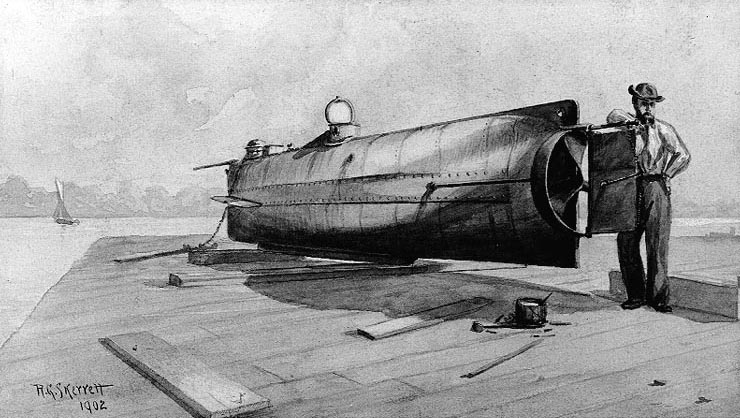
Confederate combat submarine.
Bushnell's idea was realized during Civil War between North and South. Then a submarine, developed by Confederate Horace Hanley, managed to sink the Northern ship thanks to a mine installed on the bow. However, everything ended badly for the crew of the submarine - she herself received a hole, and her crew, led by the inventor himself, died.
The Russian submarine fleet is 110 years old.
At the turn of the XIX-XX centuries. The leadership of the Russian Empire began to clearly understand the need to create its own military submarine fleet.
This need was caused by the successful development of a similar shipbuilding industry in Europe and the USA. And already in January 1901, at the suggestion of the chief inspector of Russian shipbuilding, Lieutenant General E.N. Kuteynikov, professional design of domestic combat submarines began in St. Petersburg. By this time, the industrial production of electric motors and electric batteries had already been mastered, making it possible to ensure the movement of a submarine underwater, internal combustion engines, including diesel engines, which were highly economical and turned out to be most suitable as surface engines. Torpedoes turned out to be the most effective as underwater weapons for submarines, which allowed them to attack surface ships both at anchor and moving on the open sea.
On January 4, 1901, the Naval Ministry approved the “Submarine Construction Commission,” headed by the talented shipbuilding engineer I.G. Bubnov. The commission developed a project for the first domestic combat-ready submarine "Dolphin". In 1901, I.G. Bubnov was appointed its builder at the Baltic Shipyard, supervised its testing and commissioning of the fleet.
On August 29, 1903, the first Dolphin submarine, almost completely finished and standing at the outfitting wall of the plant, was visited by Emperor Nicholas II. The Emperor was pleased, and the boat was put into service. This was the beginning of the creation of submarine forces Russian fleet. It should be noted that the construction of the Dolphin submarine was clearly experimental in nature and it did not have much combat value. This was the first-born of our submarine forces.
Emperor Nicholas II accepts the report of the commander of the submarine "Dolphin", Captain II Rank M.K. Beklemishev at the Baltic Shipyard.
In connection with the start of the construction of submarines, the issue of training personnel: crews and specialist officers to serve on them became acute: they were staffed exclusively by volunteers. The training took place on the submarine "Dolphin", which was also the first training submarine for training submarine specialists, and Captain 2nd Rank M.N. Beklemishev was their first commander-mentor and teacher.
There were also losses. So on June 29 (16), 1904, during the 18th training dive on the Neva, the submarine “Dolphin” sank. The “Dolphin” was commanded on this outing by Lieutenant A.N. Cherkasov. Besides him, there were two officers and 34 lower ranks on the boat, of which only four belonged to the Dolphin team, the rest were learning the basics of scuba diving “in order to accustom them to being on a boat underwater.” A. Cherkasov obviously did not take into account the overload of the boat (24 people weigh about 2 tons) and, as a consequence of this, a greater than usual diving speed.
The emergency situation was aggravated by the design flaws of the boat. Only 2 officers and 10 sailors were saved. Lieutenant A.N. Cherkasov and 24 sailors did not have time to leave and died. Three days later the submarine was raised. The submariners were buried at the Smolensk cemetery. 24 names of the victims are engraved on the tombstone. Lieutenant A.N. Cherkasov is buried nearby in a separate grave. On his tombstone there is an inscription: “Here lies the body of Lieutenant Anatoly Nilovich Cherkasov, who died on the destroyer Dolphin on June 16, 1904, along with a crew of 24 people. Lower ranks." These were the first losses of the first combat submarine of the Russian fleet.
Dolphin" in Vladivostok.
Russo-Japanese War 1904-1905 became the first in world history in which submarines took part - ships of a new type, which by this time were just beginning to take their place in the military fleets of the leading maritime powers of the world.
In April 1904, the battleships Yashima and Hatsuse were blown up by mines near Port Arthur, but the Japanese believed that they were being attacked by submarines, and the entire squadron fired long and furiously into the water. The commander of the 1st Pacific Squadron, Rear Admiral V.K. Vitgeft, ordered that when the Japanese battleships were blown up, a radiogram was given that the admiral thanked the submarines for a successful job. Of course, the Japanese intercepted this message and “took note of it.” In 1904, to Vladivostok railway submarines began to be dispatched.
At the end of December 1904, eight submarines were already there. On January 14 (1), 1905, by order of the commander of the Vladivostok port, all these boats were organizationally included in the Separate Detachment of Destroyers, which, in turn, was subordinate to the head of the Vladivostok cruiser detachment, Rear Admiral K. Ya. Jessen. Direct management of the actions of the Separate Detachment was entrusted to the commander of the Kasatka submarine, Lieutenant A.V. Plotto, and Lieutenant I.I. Riznich, who commanded the submarine “Pike,” was appointed his deputy. A. Plotto was the first commander of the first tactical Separate detachment of submarines (Born A.V. Plotto on March 12, 1869, later vice admiral, naval leader, theorist and practitioner of diving. Died in 1948 at the age of 79 years , buried in Piraeus (Greece)). By the end of 1905, there were 13 submarines in Vladivostok.
At the beginning of the Russo-Japanese War, none of the countries in the world had yet developed meaningful views on the role of submarines in their fleets. Therefore, the Russian Maritime Department had to develop plans for the use of its submarines in a war at sea, without any experience. No one really had any idea what submarines were capable of or how they should operate.
The Soma commander, Lieutenant Prince Vladimir Vladimirovich Trubetskoy, wrote that “... essentially no one was in charge of the boats, and those commanders who wanted to do something were not given the initiative...”. And further: “...I had to do everything for the first time, even coming up with command words to control the boat. They were mainly developed by the commander of the Skat, Lieutenant Mikhail Tieder, and the commander of the Shchuka, Lieutenant Riznich (many of these “command words” have survived to this day: “Stand in places. To ascend,” “Stand in places. To dive.” , “Blow out the ballast”, “Look around in the compartments” and others). Their combat activities were reduced to patrol duty, conducting short-range reconnaissance and protecting the coast in the Vladivostok area.
Only in one case did Russian submarines, while performing patrol duty and conducting reconnaissance, manage to detect Japanese ships. For the first time in combat practice, the Russian submarine officer commander of the Soma, Lieutenant Prince V.V. Trubetskoy, saw through the periscope not a training target shield, but enemy ships. He decided to attack the enemy. "Som" submerged and began maneuvering in order to take a convenient position for a salvo, but the Japanese ships discovered it, opened fire and went to ram. “Som” dived to 12 meters and performed an evasive maneuver in order to again take a convenient position for firing a torpedo salvo. But the fog that suddenly fell on the sea allowed the enemy ships to escape. Although there was no military clash and this attack was not successful, it played a positive role.
This incident was the attempt of the first underwater attack in the history of the Russian submarine fleet and was carried out by Lieutenant Prince V.V. Trubetskoy. For the first time in world history, new opponents met - surface ships and a submarine, starting on that distant day a confrontation that has not ended to this day.
At first, the submarines belonged to the class of destroyers. By 1906, Russia had 20 such submarine destroyers. This circumstance led to the fact that on March 11, 1906, the Maritime Department, Vice Admiral A.A. Birilev, signed order No. 52, in which the Emperor established a new fleet in Russia - a submarine one.
From this time on, the history of Russian submarine forces began as a branch of the Navy. Just three weeks after Order No. 52, the first scuba diving training squad in Russia was officially created. The purpose of the detachment was to train submariners, accept submarines from industry, man them, and put them into operation.
"Trout"
This boat was built by Krupp in 1902-1903 at his own expense in order to attract the attention of the German government to submarines, the construction of which was widespread in the main maritime states. Thus, the Trout was the embryo of the German submarine fleet. The boat was built in great secrecy, but had no combat value.
The Trout's displacement was 17/18 tons. A battery of electric batteries and an electric motor provided the boat with a speed of no more than 4-5 knots and a cruising range of about 20 miles at a speed of 3.5 knots. The boat's armament consisted of 2 torpedo tubes installed outside hull 2.
Upon arrival in Vladivostok, this boat aroused distrust among Russian sailors, among whom there were no people willing to sail on it. Only after sailing on the “Trout” of Beklemishev himself were sailors who expressed a desire to serve on this boat. However, she did not go to sea, settling in the harbor “in a state of readiness” since September 1904.
"Catfish"
The submarine "Som" (formerly "Fulton") is one of the first combat submarines built by the Dutch company, which intended to sell it to the US government. In connection with the outbreak of war with Japan, Russia acquired this boat. The boat was finally assembled in St. Petersburg at the Nevsky Plant and sent to Vladivostok. On February 1, 1905, the boat was ready to go to sea, but it was missing the torpedoes that remained in St. Petersburg (they arrived only at the end of March). The first practical shooting on the Soma took place on April 13.
The seaworthiness of this boat was low. The gasoline engine often broke down. The boat commander reported: “At the end of swimming under water, there is always water in the cylinders of the gasoline engine; the measures taken did not lead to the desired results.” In addition, the battery pack was unreliable.
"Pike"
This boat of the “Som” type was built by the Nevsky Plant in 1904 according to Holland’s design, sent from St. Petersburg to the Far East in the summer of 1905 and finally assembled in Vladivostok on November 4, 1905. The delay in the readiness of the boat occurred due to many alterations, including in particular, alterations of the air duct.
On the Pike, the living conditions for personnel were much worse due to the use of longer torpedoes, which took up a lot of space in the bow compartment, where the crew was crazy. The boat commander reported that the life of the crew on campaigns was “becoming unbearable.”
"Killer Whale"
Four boats of this type arrived in Vladivostok in mid-December 1904; of these, only one “Kasatka” was tested in the Gulf of Finland for diving and underwater passage before being sent to the Far East. After installation was completed in Vladivostok, in March 1905, the Killer Whale sailed underwater.
On April 9, the Killer Whale reached the Korean shores and passed south of Gishkevich Bay. After being on the voyage for 7 days, the boat returned due to rusting of the torpedoes. The commander reported that steel torpedoes were unsuitable for active operations (in fact, the only fault was the lack of lubrication of the torpedoes).
"Scat"
The boat arrived in Vladivostok with major deficiencies. It was finally assembled on March 29, 1905 and from April 3 began to go to sea for the purpose of combat training. Torpedo firing began on June 13; out of 10 shots, 6 were successful, 3 torpedoes went off course and one buried itself.
During the voyage, many shortcomings were revealed. Reviews from the boat commander noted the slowness of the dive: “the tanks could be filled within 5-6 minutes.” In addition, the difficulty of controlling the vertical rudder was noted: “To shift the rudder from side to side, 140 turns of the steering wheel are required... the helmsman becomes very tired... hence the delayed action of the rudder and large circulation under water.” Along with this, the commander reported on the vertical instability of the boat while underwater and proposed increasing the area of the horizontal rudders, making them more balanced. The report particularly noted a design flaw in the deckhouse: in stormy weather, water entered the boat through the entrance hatch. which could not be closed when gasoline engines were running.
"Field Marshal Count Sheremetev"
This boat was finally assembled in Vladivostok and began sailing in early May 1905. On May 9, the dynamo was damaged, which took 10 days to fix. Then the boat began firing torpedoes: the first three shots were good, the rest were unsuccessful due to the delay of the tail section of the torpedo by the “tongs” of the lattice apparatus. During the examination, it was discovered that the springs that opened the “tongs” when the torpedo exited the apparatus were corroded.
"Burbot"
The Nalim submarine was finally assembled in Vladivostok on May 7, 1905. Already on May 9, one of the batteries exploded - from a spark when changing the fuse. The boat's voyage was initially very unsuccessful due to the fact that the equipment was poorly mastered by the personnel. During the summer of 1905, the boat several times suddenly and with a large trim went to a depth of up to 55 m.
"Sturgeon"
Due to the alteration of the transporter, this Lack submarine was able to be sent from St. Petersburg only in March 1905. On May 12, the Sturgeon boat was launched and began diving in the harbor. On June 14, when charging the batteries for the first time, it was discovered that they were all damaged.
"Zander"
This boat only began training in underwater swimming on August 2 and on September 21 it fired its first torpedoes, which, when leaving the apparatus, went well towards the target.
"Mullet"
This boat (also Lack) was launched on August 5th. The first dive took place on October 12. From October 14 she went to sea to explore the bays; On November 15, a pump gear tooth broke due to a foreign object. On November 21, the damage was corrected.
Lack's other boats were never completed until the end of 1905. Lately Materials about the participation of the Keta boat in military operations became known. In 1904, Lieutenant Yanovich-2nd rebuilt one of Drzewiecki’s boats according to his own design. A gasoline engine was installed; the boat was armed with a torpedo tube, the boat's hull was lengthened, and as a result of the conversion, a completely new semi-submersible ship was obtained.
Tags:




